Data-Driven Digital Innovation Networks for Urban Sustainable Development: A Spatiotemporal Network Analysis in the Yellow River Basin, China
Abstract
1. Introduction
2. Literature Review
3. Theoretical Analysis of Urban Digital Innovation Networks and Their Driving Mechanisms
4. Materials and Methods
4.1. Study Area
4.2. Research Methods
4.2.1. Constructing Urban Digital Innovation Networks: A Modified Gravity Model Approach
4.2.2. Evolutionary Characteristics of Urban Digital Innovation Networks: A Social Network Analysis Approach
- (1)
- Network Density (D): Reflects the degree of interconnectedness among cities in the network, calculated as the ratio of existing relationships to the maximum possible connections.
- (2)
- Network Connectivity (C): Measures the extent to which city nodes can establish direct or indirect connections, indicating the network’s stability and vulnerability.
- (3)
- Network Efficiency (E): Assesses the level of redundancy in inter-city interactions for digital innovation advancement.
- (4)
- Network Hierarchy (H): Quantifies the degree of asymmetric accessibility within the network, with higher values indicating more pronounced hierarchical structures.
- (1)
- Degree Centrality (CD): Indicates a city’s prominence within the network, with higher values suggesting a more central role and greater autonomy.
- (2)
- Closeness Centrality (CC): Represents a city’s proximity to all other nodes, reflecting its capacity for rapid communication and collaboration within the network.
- (3)
- Betweenness Centrality (CB): Measures a city’s intermediary function, with higher values signifying a more significant role in facilitating information flow and resource exchange.
4.2.3. Driving Factors of Urban Digital Innovation Networks: A Quadratic Assignment Procedure Analysis
- (1)
- Calculating the correlation coefficient between the dependent variable matrix and each independent variable matrix.
- (2)
- Performing random permutation of row and column labels of one matrix and computing the correlation coefficient between the permuted and unpermuted matrices. This process is repeated multiple times (typically thousands or tens of thousands) to generate a distribution of correlation coefficients.
- (3)
- Comparing the initial correlation coefficient with the distribution obtained from the permutation process, and determining statistical significance by assessing whether the coefficient falls within the critical region. The significance of the relationship is typically evaluated at conventional levels (0.01, 0.05, or 0.10), with coefficients within these levels indicating strong associations between the matrices under study [48].
4.3. Variable Selection and Data Sources
- (1)
- Defining the scope of core digital economy industries.
- (2)
- Matching industries with patent classifications.
- (3)
- Extracting and processing patent data.
5. Results
5.1. Analysis of Evolution Characteristics of Urban Digital Innovation in the Yellow River Basin
5.2. Analysis of Evolution Characteristics of Urban Digital Innovation Networks in the Yellow River Basin
5.2.1. Characteristics of Overall Network Structure
5.2.2. Characteristics of Individual Network Structure
5.3. Analysis of Driving Mechanisms of Urban Digital Innovation Networks in the Yellow River Basin
5.3.1. Model Construction and Driving Factors
- (1)
- Geographical proximity (Dist): Measured by the straight-line distance matrix between Yellow River Basin cities.
- (2)
- Factor mobility [55]: Encompassing differences in innovation, talent, and financial factors. (a) Innovation factor difference (Inno): Represented by the inter-city patent grant difference matrix. (b) Talent factor difference (Lab): Represented by the inter-city difference matrix of employees in information transmission, computer services, and software industries. (c) Financial factor difference (Fin): Represented by the inter-city difference matrix of the ratio of year-end financial institution loan balance to GDP.
- (3)
- Market mechanism (Mark): Reflected in cities’ varying purchasing power for UDI factors, represented by the inter-city difference matrix of the ratio of total retail sales of consumer goods to GDP.
- (4)
- Industrial foundation (Ind): Represented by the inter-city difference matrix of digital economy development levels. This study employs an index system comprising: telecom business revenue; employment in information transmission and software industries; Internet broadband access users; mobile phone users; and inclusive finance index. These indicators are synthesized using the entropy method to measure urban digital economy development.
- (5)
- Government intervention (Gov): Reflected by the inter-city difference matrix of the ratio of science and technology expenditure to fiscal expenditure.
5.3.2. Multicollinearity Diagnostics and Model Specification Considerations
5.3.3. Empirical Results of Driving Mechanisms
6. Conclusions and Discussions
6.1. Conclusions
6.2. Research Contributions
6.3. Practical Implications
6.4. Research Limitations
- (1)
- Data and Measurement Limitations: Although patent data serve as a representative metric for urban digital innovation assessment, they present methodological challenges including locational mismatches, commercialization gaps, and spatial deployment inconsistencies. Patents may not adequately capture the diverse characteristics of urban digital innovation in the evolving digital economy. Future research should triangulate patents with complementary innovation proxies such as startup density, venture capital flows, and digital platform launches, while expanding the measurement framework to include technological, managerial, and institutional innovation indicators.
- (2)
- Analytical Framework Constraints: Our analysis encompasses five driving dimensions but potentially overlooks significant factors including digital infrastructure disparities, socio-cultural similarities, multi-stakeholder collaboration mechanisms, and environmental sustainability dimensions. The study primarily focuses on government-led and enterprise-driven networks while underestimating the role of NGOs, research institutes, and private sector intermediaries. Additionally, the framework emphasizes economic structures while neglecting environmental impacts such as digital infrastructure carbon footprints and resource consumption. Future research should integrate sustainability indicators, multi-stakeholder network analysis, and comprehensive infrastructure metrics.
- (3)
- Generalizability Limitations: The findings are limited to the Yellow River Basin context, potentially restricting applicability to other major river basin economies such as the Yangtze River Delta and Pearl River Delta regions. Comparative analysis across different river basins with varying economic development levels, institutional frameworks, and innovation ecosystems would enhance the robustness and generalizability of our theoretical framework and empirical findings.
Author Contributions
Funding
Data Availability Statement
Conflicts of Interest
References
- Yu, S.; Liu, D.; Gao, J. Can’t Have Your Cake and Eat It Too? The Impact of Digital Infrastructure Construction on Urban Ecological Welfare Performance—A Quasi-Natural Experiment Based on the “Broadband China” Strategy. Land 2024, 13, 2125. [Google Scholar] [CrossRef]
- Ciriello, R.F.; Richter, A.; Schwabe, G. Digital Innovation. Bus. Inf. Syst. Eng. 2018, 60, 563–569. [Google Scholar] [CrossRef]
- Chae, B. A General Framework for Studying the Evolution of the Digital Innovation Ecosystem: The Case of Big Data. Int. J. Inf. Manag. 2019, 45, 83–94. [Google Scholar] [CrossRef]
- Ge, C.; Lv, W.; Wang, J. The Impact of Digital Technology Innovation Network Embedding on Firms’ Innovation Performance: The Role of Knowledge Acquisition and Digital Transformation. Sustainability 2023, 15, 6938. [Google Scholar] [CrossRef]
- Zhou, C.; Zhang, X.H.; Zhang, Q.; Liu, B.H. Construction and Spatial Difference Research of “Five in One” Comprehensive Evaluation System in Yellow River Basin. J. Desert Res. 2021, 41, 1–11. [Google Scholar]
- Hao, J.; Zhang, Y.; Guo, L. Research on a Multidimensional Dynamic Environmental Assessment: Based on the PSR Analysis Framework and Bootstrap-DEA Model, in the Yellow River Basin, China. Land 2024, 13, 2063. [Google Scholar] [CrossRef]
- Wang, G.; Yuan, Q.; Jiao, Y. Impact of the Digital Economy on Low Carbon Sustainability Evidence from the Yellow River Basin. Front. Energy Res. 2024, 12, 1292904. [Google Scholar] [CrossRef]
- Yoo, Y.; Henfridsson, O.; Lyytinen, K. Research Commentary–The New Organizing Logic of Digital Innovation: An Agenda for Information Systems Research. Inf. Syst. Res. 2010, 21, 724–735. [Google Scholar] [CrossRef]
- Fichman, R.G.; Dos Santos, B.L.; Zheng, Z.E. Digital Innovation as a Fundamental and Powerful Concept in the Information Systems Curriculum. MIS Q. 2014, 38, 329–343. [Google Scholar] [CrossRef]
- Nambisan, S.; Lyytinen, K.; Majchrzak, A.; Song, M. Digital Innovation Management: Reinventing Innovation Management Research in a Digital World. MIS Q. 2017, 41, 223–238. [Google Scholar] [CrossRef]
- Autio, E.; Nambisan, S.; Thomas, L.D.W.; Wright, M. Digital Affordances, Spatial Affordances, and the Genesis of Entrepreneurial Ecosystems. Strateg. Entrep. J. 2018, 12, 72–95. [Google Scholar] [CrossRef]
- Vial, G. Understanding Digital Transformation: A Review and a Research Agenda. J. Strateg. Inf. Syst. 2019, 28, 118–144. [Google Scholar] [CrossRef]
- Popkova, E.G.; De Bernardi, P.; Tyurina, Y.G.; Sergi, B.S. A Theory of Digital Technology Advancement to Address the Grand Challenges of Sustainable Development. Technol. Soc. 2022, 68, 101831. [Google Scholar] [CrossRef]
- Liu, Y.Q.; Han, J.M.; Wang, J.G.; Hua, L.L. Analysis on Patent Technology Distribution, Evolution and Cooperation Innovation Network of Artificial Intelligence. China Sci. Technol. Forum 2021, 37, 64–74. [Google Scholar]
- Liu, Y.W.; Ouyang, Y. Spatial-Temporal Characteristics and Dynamic Evolution of Innovation Efficiency of China’s New Generation Information Technology Industry. J. Hunan Univ. Soc. Sci. 2020, 34, 52–61. [Google Scholar]
- Paunov, C.; Guellec, D.; El-Mallakh, N.; Planes-Satorra, S.; Nüse, L. On the Concentration of Innovation in Top Cities in the Digital Age. In OECD Science, Technology and Industry Policy Papers; OECD Publishing: Paris, France, 2019; 48p. [Google Scholar]
- Chen, H.; Sun, Y.C.; Xiong, C.L. Resource Portfolio Configuration Logic for Improving Digital Government Construction Performance: A Dynamic QCA Analysis Based on Panel Data of 30 Key Cities in China. Urban Probl. 2024, 43, 15–26. [Google Scholar] [CrossRef]
- Putra, Z.D.W.; Van Der Knaap, W.G. Urban Innovation System and the Role of an Open Web-Based Platform: The Case of Amsterdam Smart City. J. Reg. City Plan. 2018, 29, 234. [Google Scholar] [CrossRef]
- Mi, C.M.; Lu, Y.; Wang, Y.J. Design and Research of Innovation Index under the Background of “Internet+”: Taking Jiangsu Province as an Example. Sci. Technol. Manag. Res. 2018, 38, 1–5. [Google Scholar]
- Huang, C.Q.; Zhang, J.; Xie, C.L. Research on Construction and Evaluation of Innovation Capability Development Index of China’s Internet Industry. J. Shantou Univ. Humanit. Soc. Sci. 2016, 32, 146–153. [Google Scholar]
- Wang, Z.; Tang, P. Substantive Digital Innovation or Symbolic Digital Innovation: Which Type of Digital Innovation Is More Conducive to Corporate ESG Performance? Int. Rev. Econ. Financ. 2024, 93, 1212–1228. [Google Scholar] [CrossRef]
- Huang, Q.; Xu, C.; Xue, X.; Zhu, H. Can Digital Innovation Improve Firm Performance: Evidence from Digital Patents of Chinese Listed Firms. Int. Rev. Financ. Anal. 2023, 89, 102810. [Google Scholar] [CrossRef]
- Huang, H.; Zhao, L. Does Digital Innovation Help Firms Navigate the COVID-19 Pandemic? Evidence from China. Emerg. Mark. Rev. 2024, 62, 101171. [Google Scholar] [CrossRef]
- Ralston, P.; Blackhurst, J. Industry 4.0 and Resilience in the Supply Chain: A Driver of Capability Enhancement or Capability Loss? Int. J. Prod. Res. 2020, 58, 5006–5019. [Google Scholar] [CrossRef]
- Ma, Z.; Xiao, H.; Li, J.; Chen, H.; Chen, W. Study on How the Digital Economy Affects Urban Carbon Emissions. Renew. Sustain. Energy Rev. 2025, 207, 114910. [Google Scholar] [CrossRef]
- Bai, D.; Li, M.; Wang, Y.; Mallek, S.; Shahzad, U. Impact Mechanisms and Spatial and Temporal Evolution of Digital Economy and Green Innovation: A Perspective Based on Regional Collaboration within Urban Agglomerations. Technol. Forecast. Soc. Change 2024, 207, 123613. [Google Scholar] [CrossRef]
- Pan, W.; Xie, T.; Wang, Z.; Ma, L. Digital Economy: An Innovation Driver for Total Factor Productivity. J. Bus. Res. 2022, 139, 303–311. [Google Scholar] [CrossRef]
- Hu, C.; Mao, J.; Tian, M.; Wei, Y.; Guo, L.; Wang, Z. Distance Matters: Investigating How Geographic Proximity to ENGOs Triggers Green Innovation of Heavy-Polluting Firms in China. J. Environ. Manag. 2021, 279, 111542. [Google Scholar] [CrossRef]
- Huang, Y.; Wang, Y. How Does High-Speed Railway Affect Green Innovation Efficiency? A Perspective of Innovation Factor Mobility. J. Clean. Prod. 2020, 265, 121623. [Google Scholar] [CrossRef]
- Yu, Y.; Cheng, L.; Zhang, D. How Does Market Competition Affect Enterprise Cooperative Innovation? The Moderating Role of Intellectual Property Protection and Government Subsidies. Technovation 2024, 137, 103102. [Google Scholar] [CrossRef]
- Xu, L.; Shu, H.; Lu, X.; Li, T. Regional Technological Innovation and Industrial Upgrading in China: An Analysis Using Interprovincial Panel Data from 2008 to 2020. Financ. Res. Lett. 2024, 66, 105621. [Google Scholar] [CrossRef]
- Sohag, K.; Urazbaeva, A.; Shams, S.M.R.; Mariev, O. Government Policy Innovation in Spurring Nascent Entrepreneurship during Pandemic. Eur. Manag. J. 2024; in press, corrected proof. [Google Scholar] [CrossRef]
- Zhou, C.; Liu, B.H.; Zhang, X.H.; Tian, J.; Zhou, L. Spatial Distribution Characteristics and Influencing Factors of Cultural Relics Protection Units in the Yellow River Basin. J. Desert Res. 2021, 41, 10–20. [Google Scholar]
- Nelson, R.E. Social Network Analysis as Intervention Tool: Examples From the Field. Group Organ. Stud. 1988, 13, 39–58. [Google Scholar] [CrossRef]
- Doreian, P.; Conti, N. Social Context, Spatial Structure and Social Network Structure. Soc. Netw. 2012, 34, 32–46. [Google Scholar] [CrossRef]
- Zhong, C.; Arisona, S.M.; Huang, X.; Batty, M.; Schmitt, G. Detecting the Dynamics of Urban Structure through Spatial Network Analysis. Int. J. Geogr. Inf. Sci. 2014, 28, 2178–2199. [Google Scholar] [CrossRef]
- Abramo, G.; D’Angelo, C.A.; Di Costa, F. Knowledge Spillovers: Does the Geographic Proximity Effect Decay over Time? A Discipline-Level Analysis, Accounting for Cognitive Proximity, with and without Self-Citations. J. Informetr. 2020, 14, 101072. [Google Scholar] [CrossRef]
- Scott, A.J. Industrial Organization and Location: Division of Labor, the Firm, and Spatial Process. Econ. Geogr. 1986, 62, 215. [Google Scholar] [CrossRef]
- Yue, L.; Lei, Y.Y. Spatial Association Network Construction and Evolution Factors of Green Water Resource Efficiency in the Yellow River Basin. J. Northwest Norm. Univ. Soc. Sci. 2022, 59, 62–74. [Google Scholar] [CrossRef]
- Zhang, M.D.; Weng, A.H. Spatial Association Network and Formation Mechanism of Urban Water Resources Utilization Efficiency in the Yangtze River Economic Belt. Acta Geogr. Sin. 2022, 77, 2353–2373. [Google Scholar]
- Zhao, T.; Zhang, Z.; Liang, S.K. Digital Economy, Entrepreneurial Activity and High-Quality Development—Empirical Evidence from Chinese Cities. Manag. World 2020, 36, 65–76. [Google Scholar] [CrossRef]
- Bai, Y.; Chou, L.; Zhang, W. Industrial Innovation Characteristics and Spatial Differentiation of Smart Grid Technology in China Based on Patent Mining. J. Energy Storage 2021, 43, 103289. [Google Scholar] [CrossRef]
- Li, Y.; Liu, C.L. Spatial-Temporal Evolution and Influencing Factors of Urban Digital Technology Innovation in China. Sci. Geogr. Sin. 2024, 44, 754–765. [Google Scholar] [CrossRef]
- Zheng, X.; Le, Y.; Chan, A.P.C.; Hu, Y.; Li, Y. Review of the Application of Social Network Analysis (SNA) in Construction Project Management Research. Int. J. Proj. Manag. 2016, 34, 1214–1225. [Google Scholar] [CrossRef]
- Liu, J.-B.; Liu, B.-R.; Lee, C.-C. Social Network Analysis of Regional Transport Carbon Emissions in China: Based on Motif Analysis and Exponential Random Graph Model. Sci. Total Environ. 2024, 954, 176183. [Google Scholar] [CrossRef]
- Bai, R.; Lin, B. An In-Depth Analysis of Green Innovation Efficiency: New Evidence Based on Club Convergence and Spatial Correlation Network. Energy Econ. 2024, 132, 107424. [Google Scholar] [CrossRef]
- Kim, A.C.H.; Newman, J.I.; Kwon, W. Developing Community Structure on the Sidelines: A Social Network Analysis of Youth Sport League Parents. Soc. Sci. J. 2020, 57, 178–194. [Google Scholar] [CrossRef]
- Bai, C.; Zhou, L.; Xia, M.; Feng, C. Analysis of the Spatial Association Network Structure of China’s Transportation Carbon Emissions and Its Driving Factors. J. Environ. Manag. 2020, 253, 109765. [Google Scholar] [CrossRef] [PubMed]
- Xu, J.; Guo, X.; Jiang, Y.C. Evaluation of China’s Regional Digital Innovation Capability and Research on Spatial Correlation and Differentiation. Soft Sci. 2022, 36, 49–58. [Google Scholar] [CrossRef]
- Liu, L.; Gu, T.; Wang, H. The Coupling Coordination between Digital Economy and Industrial Green High-Quality Development: Spatio-Temporal Characteristics, Differences and Convergence. Sustainability 2022, 14, 16260. [Google Scholar] [CrossRef]
- Luo, Q.; Wang, J. Digital Finance and Green Technology Innovation: A Dual Path Test Based on Market and Government. Financ. Res. Lett. 2024, 70, 106283. [Google Scholar] [CrossRef]
- Tao, F.; Zhu, P.; Qiu, C.Z.; Wang, X.R. Research on the Impact of Digital Technology Innovation on Enterprise Market Value. J. Quant. Tech. Econ. 2023, 40, 68–91. [Google Scholar] [CrossRef]
- Zhou, H.; Li, J.B. Characteristic Facts and Analysis of China’s Digital Economy Innovation Activities—Evidence from Patents. J. Jinan Univ. Philos. Soc. Sci. 2023, 45, 54–68. [Google Scholar]
- Zhang, J.; Luo, Y. Degree Centrality, Betweenness Centrality, and Closeness Centrality in Social Network. In Proceedings of the 2017 2nd International Conference on Modelling, Simulation and Applied Mathematics (MSAM2017), Bangkok, Thailand, 26–27 March 2017; Atlantis Press: Bangkok, Thailand, 2017. [Google Scholar]
- Wang, L.; Chen, L.; Li, Y. Digital Economy and Urban Low-Carbon Sustainable Development: The Role of Innovation Factor Mobility in China. Environ. Sci. Pollut. Res. 2022, 29, 48539–48557. [Google Scholar] [CrossRef]
- Boschma, R. Proximity and Innovation: A Critical Assessment. Reg. Stud. 2005, 39, 61–74. [Google Scholar] [CrossRef]
- Cooke, P. Regional Innovation Systems, Clusters, and the Knowledge Economy. Ind. Corp. Change 2001, 10, 945–974. [Google Scholar] [CrossRef]
- Florida, R.L. The Rise of the Creative Class: Revisited; Basic Books: New York, NY, USA, 2014. [Google Scholar]
- Binz, C.; Truffer, B. Global Innovation Systems—A Conceptual Framework for Innovation Dynamics in Transnational Contexts. Res. Policy 2017, 46, 1284–1298. [Google Scholar] [CrossRef]
- Gan, C.; Voda, M.; Wang, K.; Chen, L.; Ye, J. Spatial Network Structure of the Tourism Economy in Urban Agglomeration: A Social Network Analysis. J. Hosp. Tour. Manag. 2021, 47, 124–133. [Google Scholar] [CrossRef]
- Jiang, Z.R. Coupling Research on Digital Economy and New Quality Productive Forces in Cities in the Yellow River Basin. Areal Res. Dev. 2024, 43, 29–35. [Google Scholar]
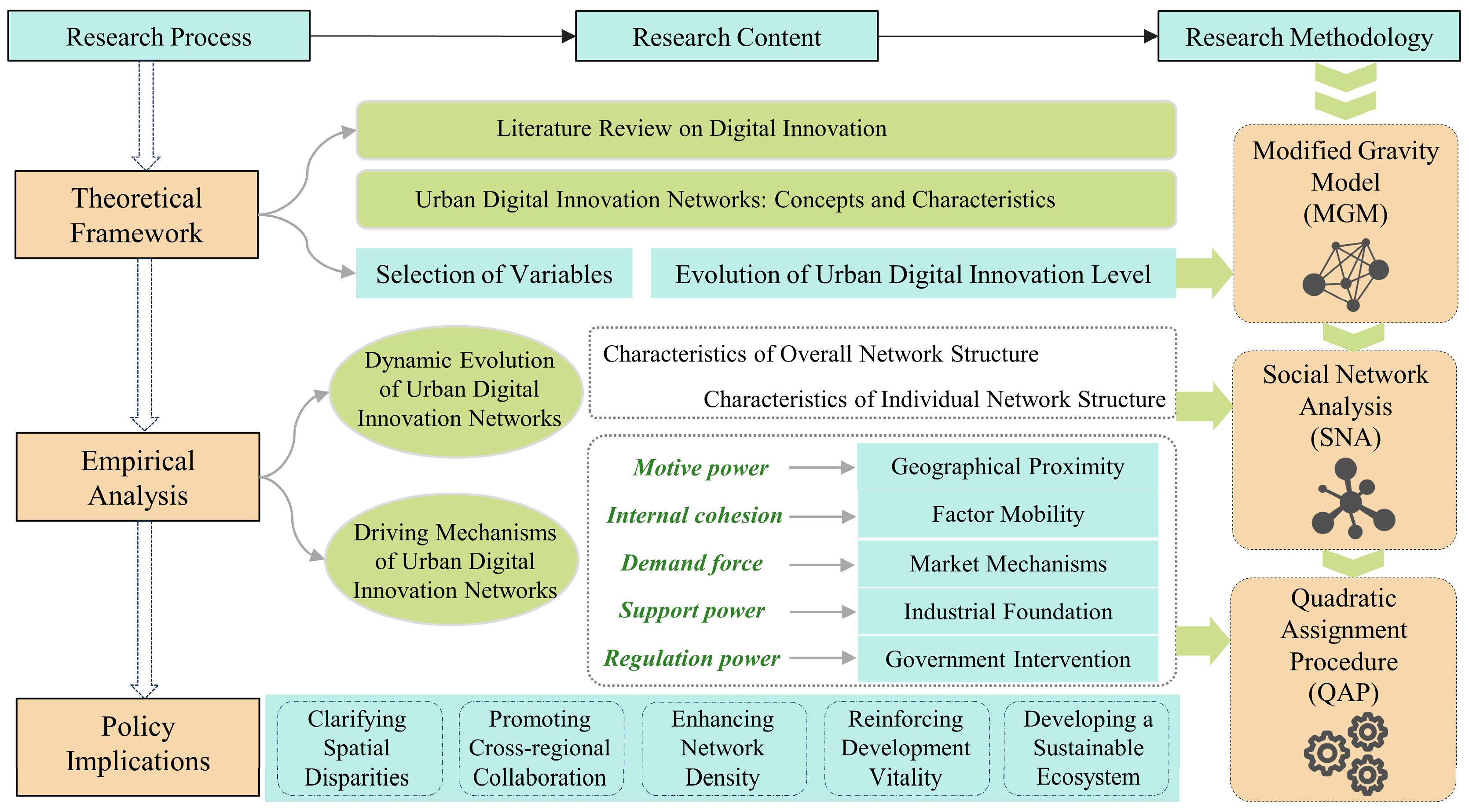
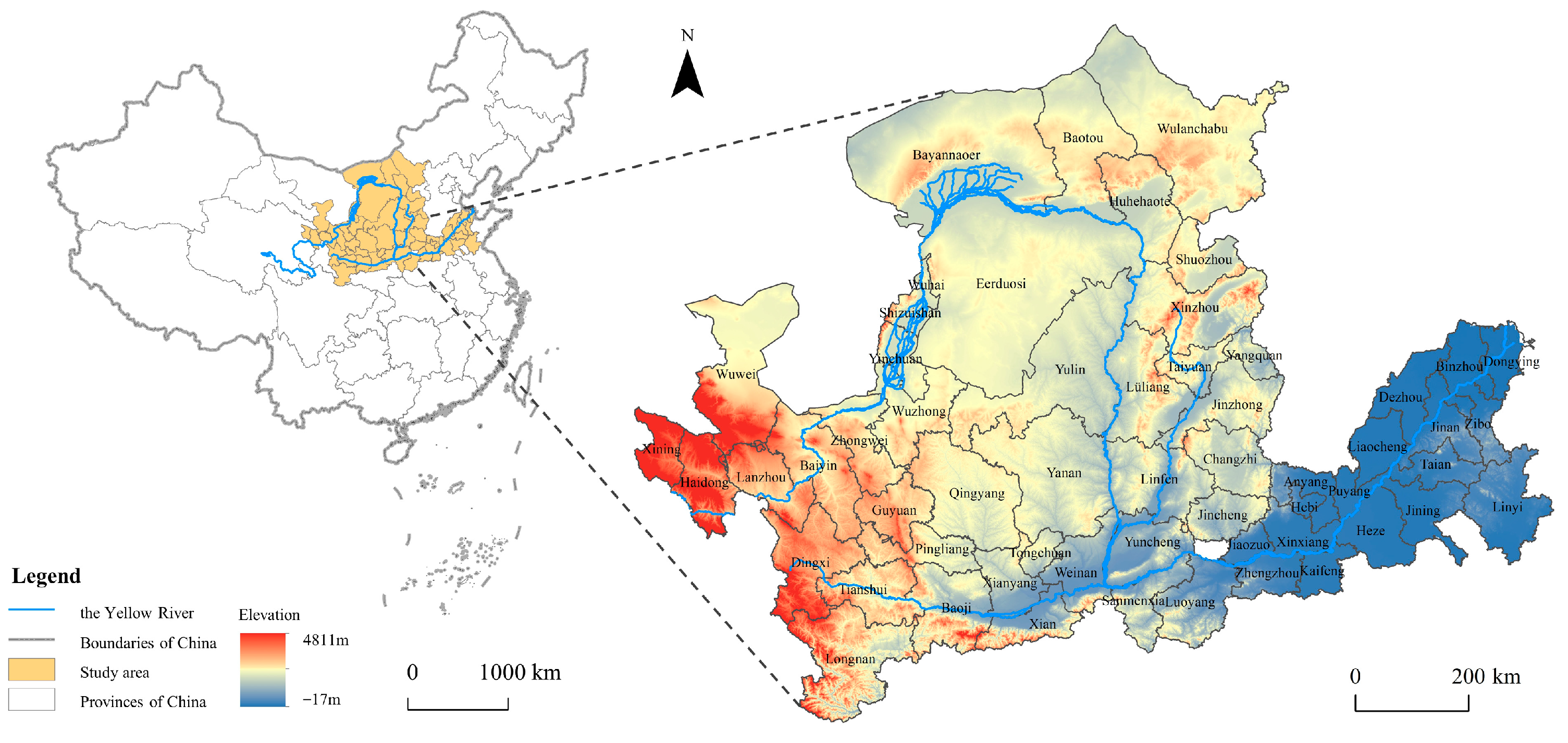
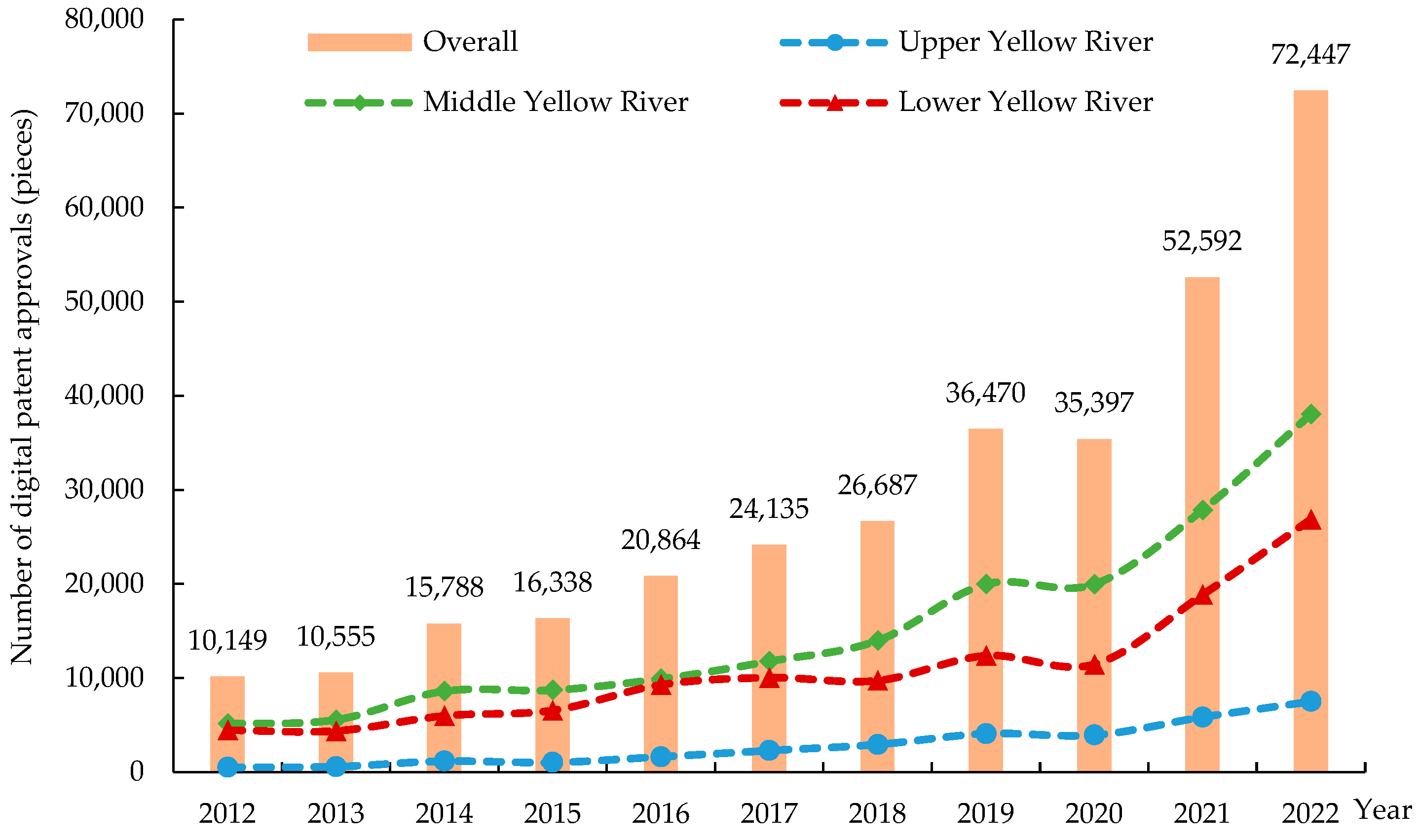

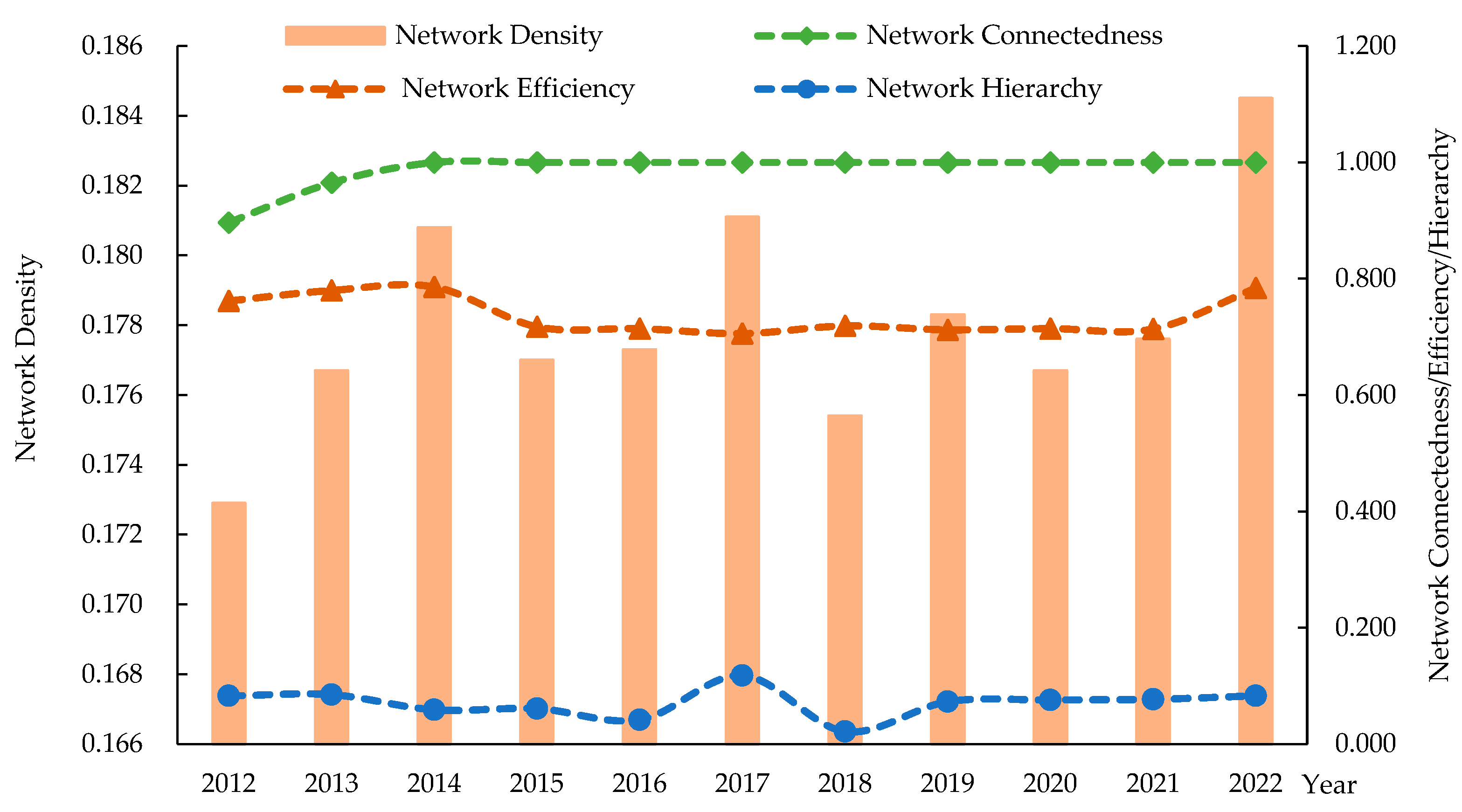
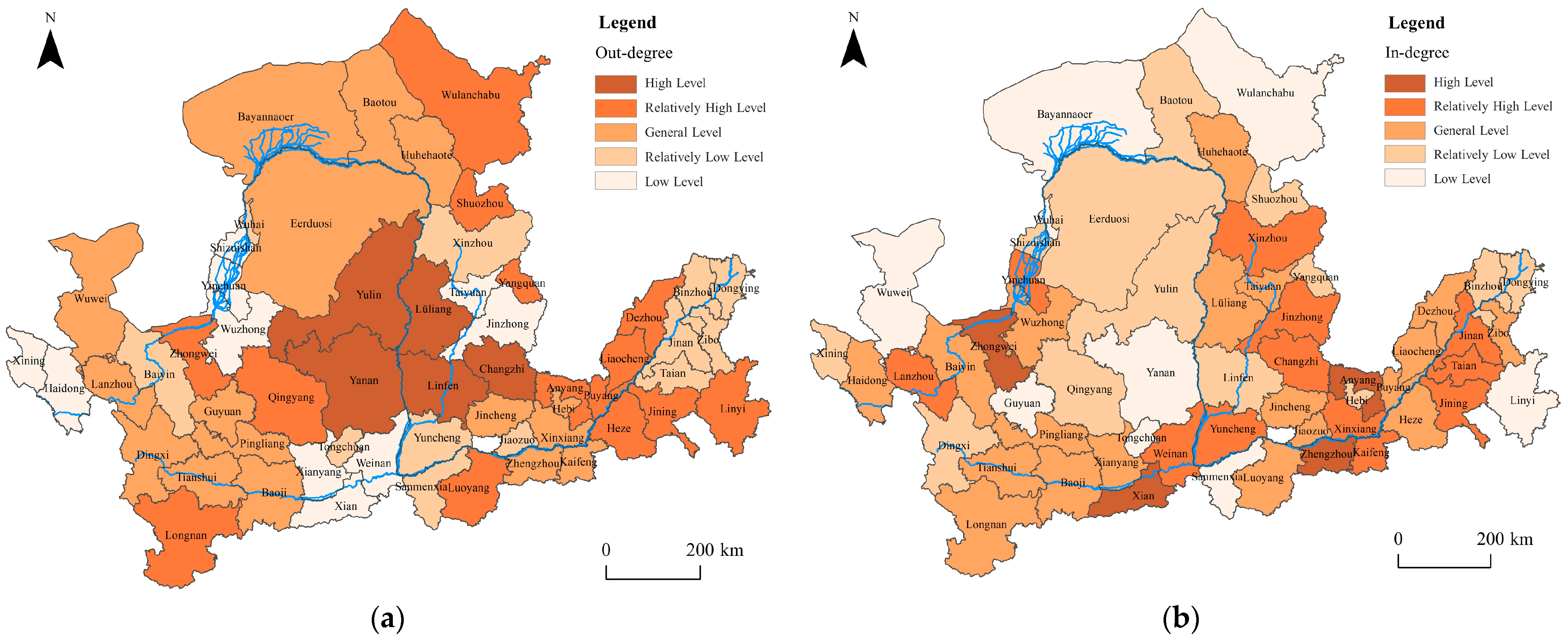
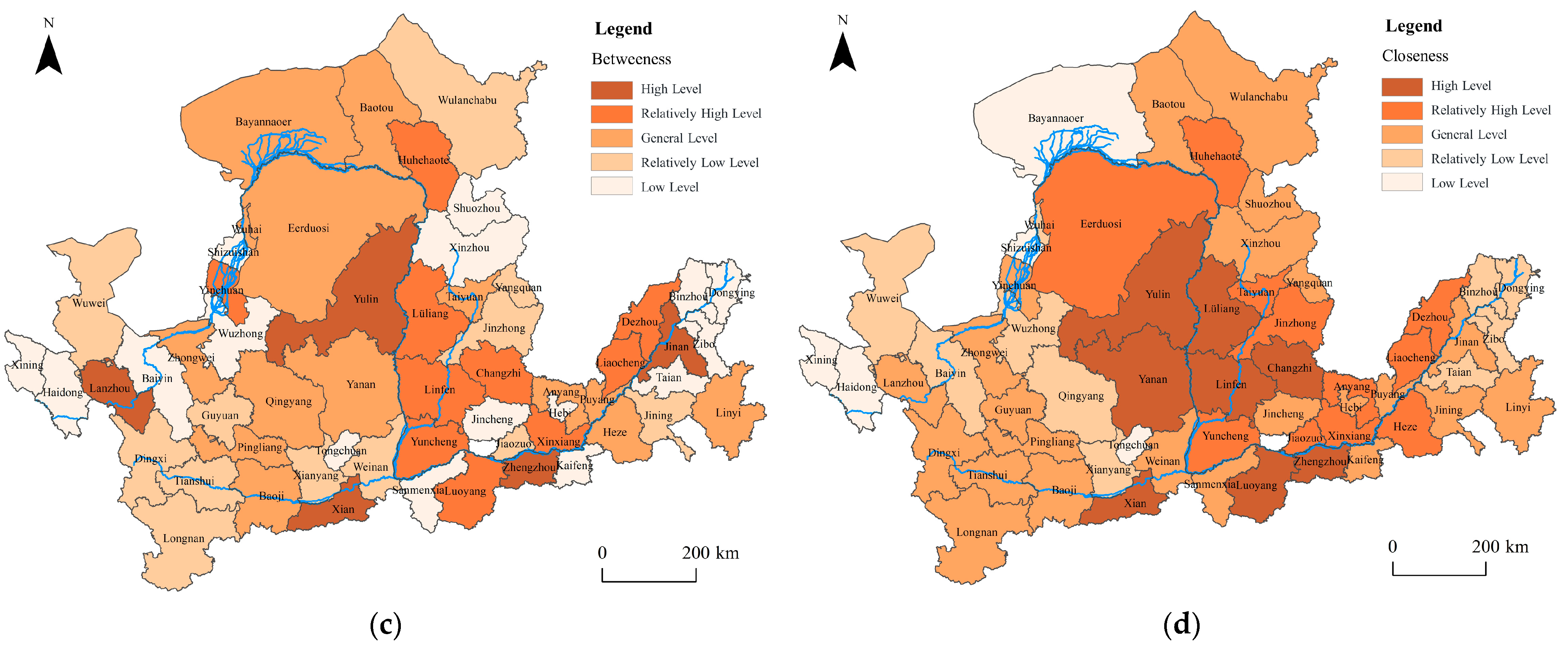
| Indicator | Equation | Description | ||
|---|---|---|---|---|
| overall network | Network density | D = l/[n(n − 1)] | (3) | n: the number of cities; l: the total number of actual network connections. |
| Network connectedness | C = 1 − v/[n(n − 1)/2] | (4) | n: the number of cities; v: the number of unreachable city pairs. | |
| Network hierarchy | H = 1 − s/max(s) | (5) | s: the number of symmetrically reachable city pairs; max(s): the maximum possible number of symmetrically reachable pairs. | |
| Network efficiency | E = 1 − k/max(k) | (6) | k: the number of redundant connections; max(k): the maximum possible number of redundant connections. | |
| individual network | Degree centrality | CRDi = (m1 + m2)/(2n − 2) | (7) | n: the number of cities; m1 and m2: the in-degree and out-degree of nodes. |
| Closeness centrality | (8) | dij: the shortest path distance between cities i and j. | ||
| Betweenness centrality | (9) | n: the number of cities; bjk(i): the betweenness centrality of city i in controlling the connectivity between cities j and k. | ||
| Influencing Factors | VIF | 1/VIF |
|---|---|---|
| Dist | 1.00 | 1.0000 |
| Inno | 1.29 | 0.7740 |
| Lab | 1.22 | 0.8217 |
| Fin | 1.96 | 0.5106 |
| Mark | 1.60 | 0.6240 |
| Ind | 1.38 | 0.7221 |
| Gov | 2.03 | 0.4937 |
| Influencing Factors | 2012 | 2014 | 2016 | 2018 | 2020 | 2022 |
|---|---|---|---|---|---|---|
| Dist | −0.135 *** (0.000) | −0.145 *** (0.000) | −0.146 *** (0.000) | −0.150 *** (0.000) | −0.135 *** (0.000) | −0.132 *** (0.000) |
| Inno | 0.058 ** (0.016) | 0.073 *** (0.007) | 0.0745 *** (0.003) | 0.079 *** (0.000) | 0.084 *** (0.000) | 0.083 *** (0.000) |
| Lab | 0.006 (0.484) | 0.006 (0.369) | 0.007 (0.377) | 0.014 (0.560) | 0.011 (0.103) | 0.009 (0.344) |
| Fin | 0.028 *** (0.003) | 0.020 * (0.087) | 0.017 ** (0.021) | 0.022 ** (0.028) | 0.030 *** (0.007) | 0.031 *** (0.004) |
| Mark | −0.012 ** (0.027) | −0.010 ** (0.038) | −0.008 ** (0.040) | −0.025 ** (0.014) | −0.006 ** ((0.030) | −0.010 ** (0.017) |
| Ind | 0.006 (0.343) | 0.019 (0.303) | 0.011 (0.355) | 0.014 (0.174) | 0.006 (0.280) | 0.008 (0.391) |
| Gov | −0.017 ** (0.021) | −0.009 ** (0.032) | −0.016 * (0.066) | −0.008 ** (0.044) | −0.019 ** (0.034) | −0.007 * (0.077) |
| Random Number Seed | 3192 | 3192 | 3192 | 3192 | 3192 | 3192 |
| Number of Permutations | 6000 | 6000 | 6000 | 6000 | 6000 | 6000 |
Disclaimer/Publisher’s Note: The statements, opinions and data contained in all publications are solely those of the individual author(s) and contributor(s) and not of MDPI and/or the editor(s). MDPI and/or the editor(s) disclaim responsibility for any injury to people or property resulting from any ideas, methods, instructions or products referred to in the content. |
© 2025 by the authors. Licensee MDPI, Basel, Switzerland. This article is an open access article distributed under the terms and conditions of the Creative Commons Attribution (CC BY) license (https://creativecommons.org/licenses/by/4.0/).
Share and Cite
Zhang, X.; Hu, H. Data-Driven Digital Innovation Networks for Urban Sustainable Development: A Spatiotemporal Network Analysis in the Yellow River Basin, China. Buildings 2025, 15, 3006. https://doi.org/10.3390/buildings15173006
Zhang X, Hu H. Data-Driven Digital Innovation Networks for Urban Sustainable Development: A Spatiotemporal Network Analysis in the Yellow River Basin, China. Buildings. 2025; 15(17):3006. https://doi.org/10.3390/buildings15173006
Chicago/Turabian StyleZhang, Xuhong, and Haiqing Hu. 2025. "Data-Driven Digital Innovation Networks for Urban Sustainable Development: A Spatiotemporal Network Analysis in the Yellow River Basin, China" Buildings 15, no. 17: 3006. https://doi.org/10.3390/buildings15173006
APA StyleZhang, X., & Hu, H. (2025). Data-Driven Digital Innovation Networks for Urban Sustainable Development: A Spatiotemporal Network Analysis in the Yellow River Basin, China. Buildings, 15(17), 3006. https://doi.org/10.3390/buildings15173006





